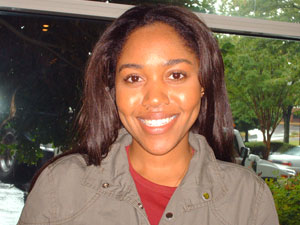FCNNEWSSOURCE
Darnide Cayo is the 25-year-old co-founder of Artists Village, Inc., a non-profit human rights organization based in Brooklyn, New York with volunteers, supporters and donors worldwide. The group’s mission is to build self-sufficient communities by providing services in rural areas of Haiti, the small island nation of just over 9-million people. Haiti is the first post colonial independent Black nation in the Western Hemisphere. She sat down with The Final Call’s Ashahed M. Muhammad recently at the 2009 National Black Power Conference in Atlanta, GA.

The Final Call (FC:) Why is the name of the group Artists Village?
Darnide Cayo (DC:) The reason it is called Artists Village is because anyone that can think of creating a better quality of life for someone in need is an artist. You don’t have to be an actual artist, a painter, or a musician. As long as you can envision helping someone, then you are painting a new portrait of help for them.
FC: What forms of aid and assistance does your group provide for those in Haiti?
DC: A lot of hurricane relief. Within the past two years we have helped feed over 3,500 families who were stranded due to the flooding. We sent beans, oil and rice. We also recently donated over $13 million dollars worth of antibiotics to Haiti this past October. It was sent to help treat over 200,000 children. We have also collected sheets for hospitals and we also collect medical supplies. But the ultimate mission is to create a series of self-sufficient communities equipped with homes, vocational schools, medical clinics. While doing the research and creating a village, I found out that during the hurricanes, the reason so many people died is due to the deforestation and when you cut down the trees, the trees no longer protect the homes from wind and rain. So when I go down to Haiti and I go into the provinces, I don’t have a green thumb but I have learned and I sit down with the children there and I teach them to plant mango trees and to plant avocado trees. It’s also for survival and food. Should the need arise, then that means that they can feed themselves as well.
FC: Certainly there are many places here in the United States where there is a need for the services that you provide. What drew you to become active in what is going on there in Haiti?
DC: Well that’s a good question. After a series of four hurricanes in 2004, I was called upon by a general counsel in New York in order to volunteer so I joined forces with BET and Metropolitan Studio because they were looking to have a telethon for the Caribbean. There was a lot of talk of having a lot of celebrities to come on and I was there to do my own humanitarian work and answering phones, as I was still in college. After two or three meetings, a Tsunami happened. So they closed up shop on the Caribbean (outreach) and all of the entertainers went over to the Tsunami efforts. So every Caribbean Island was pretty much doing for themselves and I kept researching to see if there were any organizations out there helping Haiti. My mother who is the founder of our organization–it is a mother and daughter team–has made over seven trips to Haiti and to the Dominican Republic and we found out the Haitians residing in the border of the Dominican Republic were being kicked off their land because they were building the homes there and they didn’t want to house the Haitians, they were only housing the Dominicans. After a year or two the Haitians were still sleeping on lots and under tents. So we said to ourselves that it would be great if there was an organization that would go there and build homes, build vocational schools, build storm-proof homes and help them rebuild their lives. And that is when we came up with the concept of Artists Village.
FC: When many people think of Haiti or discuss the small island nation, their views seem to be informed by what they are shown in the media–primarily a picture of poverty and AIDS. What do you think would be something surprising that you could tell people about Haiti?
DC: Haiti has some of the best architecture I’ve ever seen. The homes are gorgeous, Beverly Hills has nothing on homes I’ve seen in Haiti. Unfortunately, due to the insecurity a couple of years ago, they have been building very tall walls in order to protect the homes so that architecture has been hidden. What you see in the media is the poverty but they are not going to go and show you the beautiful homes that they have. Also, what I love most is that when you are walking around Haiti (even) the poorest of the poor are clean. They are always well groomed, they have so much pride in the way they walk. They won’t let you know that they are hungry and to me that was the biggest cultural shock of all. They have that warrior mentality. Haiti is just a victim of circumstances, political injustice and natural disasters.
FC: How extensive and far reaching are your plans? Do you plan for it to be a long-term effort?
DC: This is a lifetime mission. It was pretty much a dream that became a vision which, the vision became a mission and my mission became a reality, which is the best way I can describe it. I feel very blessed to be as young as I am and to know what my mission is in life very early on so I can see the transformation happen in front of my eyes.
FC: Thank you.
(For information on volunteering or sending donations, Visit www.ArtistsVillage.org or email [email protected].)












